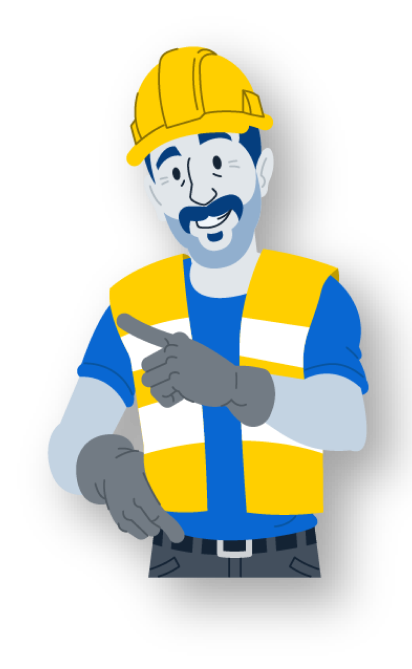As a general contractor or handyman, having the right set of construction tools is crucial to getting the job done. But what about the tools that help get the job done better, faster, or safer? Investing in the right toolkit opens up opportunities for you to offer additional services and take on more projects — positively impacting your bottom line.
Before getting into the nitty-gritty of the list, let’s make one thing clear: your smartphone is one of the most powerful tools on the job site.
Now that we have that straight…
So, where should you look when upgrading your toolkit? Instead of focusing on heavy equipment such as compressors, compactors, loaders, and excavators, we recommend looking for portable multi-tools you can bring to any job.
Here are the top tools for contractors that can elevate your business without breaking your budget.
Gear/Clothing
The first place to consider when upgrading your toolkit isn’t in your toolkit at all. It’s on you.
Your clothing options should allow you to move with ease and be long-lasting. But clothing benefits don’t have to stop there.
Check out these top picks for wearable gear that keeps you comfortable, safe, and efficient.
1. Tool Belt Set
Trudging back and forth to find the right tools wastes valuable time. Although it might seem basic, your toolbelt is an important investment.
Some tools are only needed for specific jobs. A tool bag or packout, on the other hand, gets a lot of use. It needs to be able to stand up to years of wear and tear while keeping your most essential tools handy and organized.
We recommend the Occidental Adjust-to-Fit Fat Lip Leather Tool Bag Set for contractors searching for a genuinely durable option.
Most toolbelts have a lifespan of a few years. Customers boast that the Occidental Leather Tool Bag set can withstand up to 15-plus years of regular use. This tool bag was built with the professional contractor in mind. Besides having space for all your essential tools, the Occidental Leather Tool Bag comes in a right and a left-handed version for maximum convenience. Not to mention, this tool bag includes fully adjustable belt sizing for all seasons and D‑rings for suspension systems.
2. Gloves
Many contractors focus on hearing protection and eye gear, but keep hand protection in mind too, as 70% of construction worker hand injuries result from not wearing gloves.
As a contractor, your hands are your most essential tools. Skipping out on hand protection can put you out of commission and affect your earnings.
Unfortunately, it’s hard to find gloves that give you the right amount of protection and movement. For maximum tactile sensitivity and safety, check out the Brass Knuckle SMARTCUT BKCR2403 gloves. These lightweight SMARTCUT gloves offer ANSI Cut 2 protection without impairing your fine motor skills. They’re made of 18-gauge high-performance polyethylene with a glass-fiber shell and designed to feel like you’re not wearing gloves at all. A flat polyurethane coating on the palm makes the BKCR2403 gloves ideal for maximum dexterity and handling ability on dry surfaces.
3. Lanyard
Safety is a top priority on every construction site. Let’s face it — you are your business. So, invest in a personal fall arrest system (PFAS) that empowers you to work safely from elevated heights.
A lanyard is a relatively lightweight option to keep you secure when working at a higher elevation.
For personal fall protection, we recommend Guardian’s Cable Leading Edge Lanyard. The cable is made from ¼” galvanized steel with a vinyl coating and allows for 12 feet of free fall. The integral shock absorber minimizes arrest forces to increase safety and decrease your chance of injury. Moving from one location to another while elevated increases your risk of falling, so the Cable Leading Edge Lanyard comes in dual-leg models to allow for 100% tie-off. With vinyl coating, a high-visibility shock pack cover, and a heavy-duty label cover, this cable lanyard will keep you secure and compliant longer.
Tools
Essential tools get a lot of jobs done. But as a business owner, you need more than just basic pliers, saws, and screwdrivers. If you want faster and more professional results, you need more powerful and specialized tools that stand up to frequent use.
Here are our top picks for construction tools that offer more power and safety while being versatile enough to adapt to various project types.
4. Saw
Using the wrong tools in a demolition job can tire you out and use up unnecessary work hours. Sure, you can tough it out with a hacksaw or pry it free with a crowbar, but there’s a better option.
A reciprocating saw is a tool belt must-have for anyone working on demolition or remodeling projects.
Unlike a precision miter saw or jigsaw, think of your reciprocating saw as a demolition multi-tool. This handheld tool is suitable for removing windows, walls, doors, and plumbing.
To upgrade your toolkit, we recommend the Milwaukee M18 Fuel Sawzall Reciprocating Saw. The cordless M18 Fuel Sawzall cuts faster than competitors, doubling your run-time and durability. It offers the cutting power of corded saws with the POWERSTATE™ brushless motor. With the M18 Fuel Sawzall, you get more out of each use and a five times longer overall tool lifetime. REDLINK PLUS™ Intelligence prevents the saw from overloading and ensures optimum performance each time. The M18 Fuel Sawzall’s shoe can be adjusted, and it comes with a built-in LED light and hanging hook.
5. Pipe Cutter
Whether you’re doing electrical contracting or plumbing work, a pipe cutter is an essential toolkit item. Using a pipe cutter generates faster, cleaner cuts than a simple hacksaw.
For a versatile pipe-cutting tool that you can take to multiple job sites, we recommend the KNIPEX TubiX® Pipe Cutter. KNIPEX has made a name for itself by producing practical and innovative hand tools, including pliers, pipe cutters, and pincers. The TubiX® Pipe Cutter offers quick, precise cuts for multiple materials, including copper, brass, and stainless steel. You can also use it to cut rigid steel conduits on electric projects. The pipe cutter has a simple one-hand push mechanism that allows you to adjust quickly to various tube sizes. The cutting wheel is made from high-grade ball-bearing steel and can handle pipes from ¼”-1⅜” with a wall thickness of up to 2mm.
6. Self-Leveling Laser
Finding accurate measuring tools is a must. Investing in a good laser level can speed up your efficiency and accuracy on various indoor projects. For the most accurate results, it’s best to look at self-leveling lasers.
The GCL100-40G Green-Beam Self-Leveling Cross-Line Laser with Plumb Points from Bosch has a working range of up to 165 feet. It also generates several different line modes and plumb points to fit all of your projects. With an intuitive onboard interface, you can easily navigate the laser’s multiple layout modes, and its green beams offer four times the brightness of traditional red lights. Bosch includes its exclusive VisiMax™ technology to track power consumption and tool temperature for this line laser level. Additionally, the tool is housed in a full rubber overmold with a roll cage-inspired design for maximum durability and includes an RM10 rotating mount for quick setup.
7. Rotary Hammer
When it comes to drilling holes in concrete, you need to upgrade from your regular drill for serious projects.
Hammer drills and rotary hammers can produce higher pounding forces that let you drill through masonry easily. Rotary hammers tend to be more powerful, and their “hammer-only” modes offer increased versatility.
For your masonry needs, we recommend Bosch’s PROFACTOR 18V Connected-Ready SDS-max® 1−7÷8 In. Rotary Hammer. This battery-powered rotary hammer delivers the power (delivers 9.3 foot-pounds of impact energy) you usually get from corded tools and is perfect for heavy-duty chiseling or concrete slab drilling. It’s part of Bosch’s PROFACTOR System, which combines the high-performance BITURBO Brushless Technology with a CORE18V PROFACTOR battery. The hammer comes with KickBack Control and an anti-vibration main handle for increased comfort and safety on the job.
8. Thermal Imaging Camera
Thermal cameras were reserved for utility and industrial plants in the past. However, all buildings are vulnerable to issues from thermal loss, equipment failures, and moisture.
Thermal imaging cameras are becoming an essential tool for finding and diagnosing heat loss and moisture intrusion in various construction projects.
As for finding the best camera, we recommend the FLIR E6-XT handheld infrared camera with Wi-Fi and Bluetooth. This camera uses a 43.200 (240×180) pixel infrared detector and includes an expanded (-4⁰F to 1022⁰F) temperature range. It’s practical, versatile, and user-friendly. Plus, you can download images and create reports with ease using the Wi-Fi connection and FLIR Tools mobile app. Finally, this handy little camera is protected by an IP54 enclosure allowing it to withstand a 2‑meter drop test for added durability.
Software & Technology
Your gear and power tools keep you safe and effective while on the job site. However, that’s only half of your business. Whether you specialize in plumbing, electric, or woodworking, you need to have project management skills and tools.
Check out these top software tools to help manage your projects and stay on schedule.
9. CompanyCam
CompanyCam is a photo-based solution created for contractors, by contractors. It allows you to take unlimited photos that include location and time stamps. Photos are then stored securely on the cloud, organized by project, and instantly shared to your team.
There’s no more downloading, renaming, and emailing photos. CompanyCam makes it easy to select and send photos right from the app.
You can annotate photos with drawings, arrows, comments, tags, and voice notes. Moreover, users can use the CompanyCam app to create project timelines, photo galleries, reports, and transformation images.
If you ever need to share photos with partners or clients the app boasts two incredibly useful features: galleries, where you share a collection of photos and reports, where you share a series of photos and notes.
With various integrations, sharing photos with customers and insurance adjusters has never been easier, and keeping your entire process organized has never been simpler.
10. Wearables and Site Sensors

Wearables and site sensors are game-changers for job site safety. Construction wearables are a new type of construction technology that can be woven into your crew’s protective gear or clothing. They use GPS tracking, biometrics, and environmental sensors to keep a close eye on their physical condition. They can alert you to slips, falls, unusual movements, heart rates, breathing patterns, and even temperature changes. This means fewer accidents and healthier, safer workers.
Site sensors also play a crucial role in maintaining a safe job site. These sensors keep tabs on noise levels, dust, temperature, and the presence of harmful substances. If there’s a risk nearby, these sensors will alert your team immediately, helping to prevent accidents before they happen and making the job site a much safer place to work.
Let’s Wrap it Up
Every job site and construction project comes with a unique set of challenges and needs. As a contractor, you need to be prepared with a versatile toolkit to adapt to any project.
The tools you choose affect your safety, efficiency, and work quality. If you want to stay on budget and make the most of your time, it’s worth investing in the right construction tools.
Maddy Osman is a Contributor at Hourly.
Hourly is a people platform that helps small businesses save time and money by seamlessly connecting the dots between workers’ compensation insurance, time cards and payroll.





